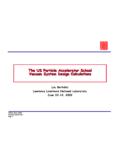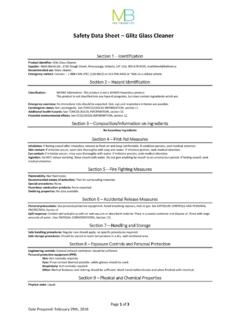Transcription of Liquid vs Dry Type (VPI) Medium Voltage …
1 10901 Commercial Street Richmond, IL 60071 800-336-5786 vs Dry Type (VPI) Medium Voltage Transformers Looking at the history of the development of Dry Type Medium Voltage Transformers they became increasingly specified in the late 1950 s and early 1960 s due primarily to the improved insulation systems (220 C) and acceptability of aluminum windings. Prior to the improvements in Dry Type Medium Voltage Transformer design, indoor installations were very often either Mineral Oil Filled which required a vault per NEC or PCB (Polychlorinated biphenyls) Liquid filled transformers. The TSCA (Toxic Substance Control Act) of 1976 prohibited the manufacture of PCB s and also the phase out of existing uses (40 CFR Part 761).
2 Due to a number of advantages Dry Type Medium Voltage Transformers became the preferred choice for most indoor and some outdoor installations. As a result of the development of the less Flammable Liquid filled transformers, a comprehensive comparison between Liquid filled transformers and Dry Type Transformers seems to be in order. This article will discuss the comparison of Liquid Filled Transformers and Dry Type (VPI) Medium Voltage Transformers. The topics discussed are as follows: NEC (National Electric Code NFPA 70) Installation requirements Factory Mutual Global clearance requirements Inspection and Testing prior to Energizing for the first time Maintenance requirements Fan Cooling capacity Basic Impulse levels Continuous overload capacity Efficiency Operating Life Expectancy Dimensional Comparison Pricing and lead time Comparison NEC Installation Requirements The installation requirements for Dry Type Medium Voltage Transformers per NEC (National Electric Code NFPA 70 ) are summarized in Table I.
3 Essentially there are very few restrictions regarding Medium Voltage Dry Type Transformers. However, proper clearances need to maintained around the Dry Type Transformer for cooling purposes and maintenance. Indoor installations for Less Flammable Liquid filled transformers (fire point not less than 300 C) have several options. Refer to Table I. The most common option for 35 KV or less, Less Flammable Liquid filled transformers in TYPE I or TYPE II buildings requires a Liquid confinement area and the installation must comply with the restrictions provided in the listing of the Liquid . Outdoor installations for Less Flammable Liquid filed transformers are permitted attached to, adjacent to, or on the roof of Type I and TYPE II Non combustible buildings as long as they comply with the restrictions of the listing of the Liquid .
4 If the installation is a combustible building or combustible materials are stored in the area then the installation would need to meet the requirements of Oil insulated transformers mounted outdoors per NEC Article Indoor installations of Oil insulated transformers would need to installed in a vault per NEC Part III of Article 450. For Outdoor installations of Oil insulated transformers if a fire hazard is present, Space separations, Fire Resistant barriers Automatic fire suppression systems or Enclosures for confinement of the oil in case of a ruptured tank may be required depending on the degree of hazard. Factory Mutual Insurance Company FM Global publishes Property loss prevention recommendations.
5 Property Loss Data sheets 5-4 covers the loss prevention recommendations related to fire protection of all transformers for large and critical distribution, power and specialty transformers. Recommended Minimum separation recommendations for Liquid insulated transformers are listed in Table II. In addition, refer to FM Global Data sheets 5-4 for loss preventive recommendations for electrical protection, electrical testing, maintenance and operation. FM Approvals Approval Standard for Less or Nonflammable Liquid insulated Transformers Class Number 3990 includes the following installations requirements. Containment of the Liquid is required for all indoor installations.
6 For TYPE I and TYPE II Non combustible buildings the transformer needs to be mounted at least 3 ft. from building walls. For combustible buildings in addition to being mounted 3 ft. from walls an automatic fire suppression system must be provided or the transformer must be located in a 3 hour fire rated vault. Outdoor installation of Less Flammable Liquid filled transformers must be installed at least 3ft. from walls and 5 ft. from doors, fire escapes and windows. In addition, containment of the Liquid is required for transformers containing 660 gal. or more of Liquid . Table INEC 2014 Installation Requirements Type of Transformer Indoor Installation Outdoor Installation Dry Type over KVA with insulation system of 155 or greater, completely enclosed except for ventilation openings and rated less than 35 KVArticle (B) Exception No.
7 2 No Restrictions Article No Restrictions Less Flammable Liquid Filled with fire point not less than 300 CArticle (A) Indoor installations are permitted if in accordance with one of the following Article (B) Outdoor installations are permitted attached to, adjacent to,or on the roof of buildings where installed in accordance of (1) or (2)(1) In type I or Type II where all of the following are met; (a) Transformer is rated 35 KV or less (b) no combustible materials are stored (c) A Liquid confinement area is provided (d) Installation complies with all restrictions provided in the listing of the Liquid (1) For Type I and Type II buildings installation shall comply with all restrictions provided for in the listing of the Liquid *(2) Automatic Fire Extinguishing system and Liquid confine ment area providing transformer is rated 35KV or less (2) In accordance with Oil insulated Transformers Installed Outdoors (3)
8 In accordance with Oil insulated Transformers installed Indoors Oil insulated Transformers Article ** Installed Indoors, Oil insulated transformers are to be installed in a vault per Part III of Article 450 Article Combustible material, combustible building and parts of building, fire escapes, door openings and window openings shall be safeguarded from fires in oil insulated transformers installed on roofs, attached to or adjacent to a building or combutible material *NEC (B) (1) Informational Note: Installations adjacent to combustible materialfire escapes, or door and window openings may require additional safeguards such as those listed in * *Refer to NEC Section exceptions 1 thru 6 References: National Electric Code NFPA 70 2014 Table II Recommended Minimun Separation for Outdoor Liquid insulated Transformers**Fluid or Transformer Type Fluid Volume (gal.)
9 Minimum Horizontal Distance from Containment to Exposed Build ing Wall2 hour fire rated wall (ft.)Non combustible wall (ft.)Combustible Wall (ft.)FM Approved transformer or equivalent Per Approval listing 3FM Approved Liquid in Non Approved transformer 10,000525 Non Approved transformer Liquid <50051525 5,000152550**For other options refer to Factory Mutual Global Prevention Data Sheets 5 4 References Factory Mutual Global Property Loss Prevention Data Sheets 5 4 Installation Requirements Mineral Oil filled transformers The transformer must be mounted on a level pad and should not be tilted beyond two degrees from Horizontal. The ambient should not be below -20 C for Mineral Oil, - O C for RTemp and -10 C for FR3.
10 Special procedures are required when energizing below -20 C. Visually Inspect all seals, gaskets, gauges, bushing, etc. for Liquid leaking. Leaks and/or improperly tightened gaskets or seals should be repaired prior to energizing the transformer. Determine if Liquid level is correct Check pressure. The transformer may have a positive or negative pressure which is acceptable. Zero pressure could indicate a gas leak and should be investigated. A leak test may need to be preformed. Recommended tests are insulation resistance (Megger test) and turns ratio test In addition, Liquid samples should be taken per ASTM D923 and tested per ASTM D-877. If dielectric strength is below acceptable level Liquid should be filtered.







